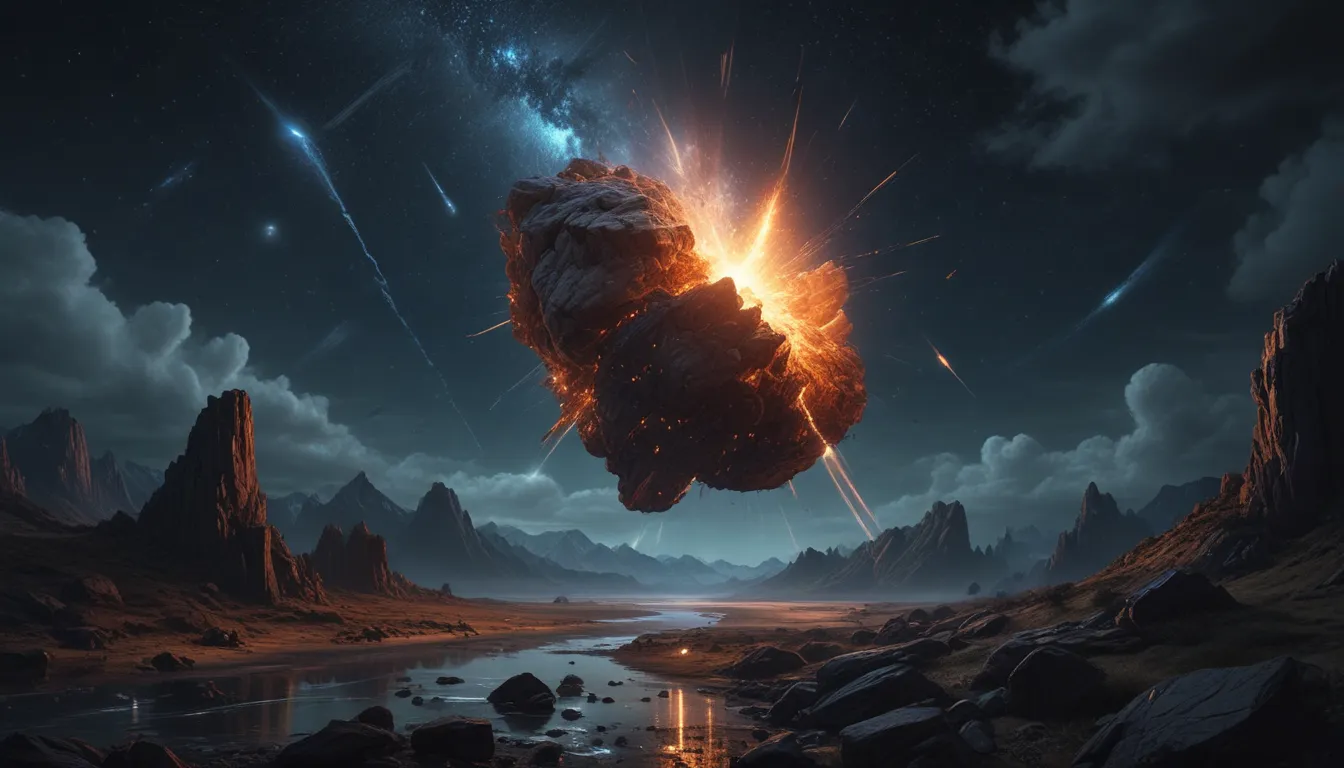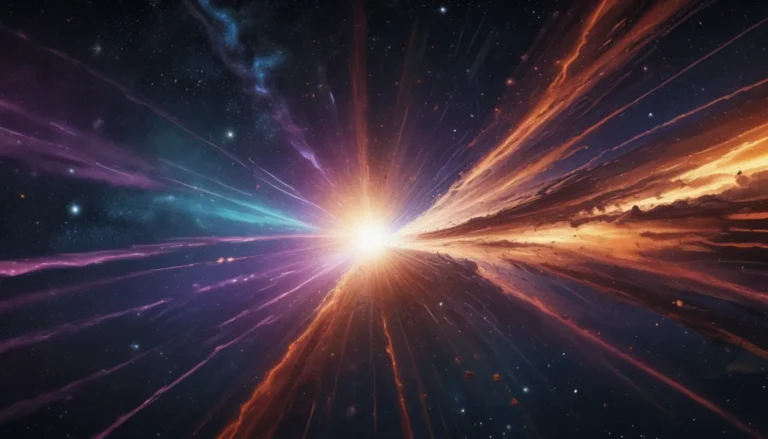The pictures we use in our articles might not show exactly what the words say. We choose these pictures to make you interested in reading more. The pictures work together with the words but don’t take their place. The words still tell you the important facts.
Meteoroids, those captivating celestial objects that traverse the vast expanse of space before entering Earth's atmosphere, hold a myriad of surprises within their rocky cores. From their origins to their impact on our planet, these extraterrestrial visitors have much to offer beyond just a sparkling light show in the night sky. Let's embark on a cosmic journey as we unravel 14 surprising facts about meteoroids that will leave you in awe of the mysteries of the universe.
Unveiling the Universe’s Cosmic Wanderers
- Meteoroids, akin to shooting stars, create mesmerizing meteor showers as they burn up in Earth's atmosphere, offering clues about the early solar system.
- These celestial voyagers, ranging from minuscule specks to massive rocks, house the secrets of the universe and contribute to shaping our planet by delivering crucial water and organic compounds essential for life.
Meteoroids, Meteors, and Meteorites – Deciphering the Terminology
Before delving into the captivating world of meteoroids, let's clarify some crucial terminology. A meteoroid refers to a small object floating in space, typically composed of rocks, minerals, and even metals. When a meteoroid enters Earth's atmosphere and ignites due to friction, it transforms into a meteor. If it survives its fiery descent and lands on Earth's surface, it becomes a meteorite. These three stages play a pivotal role in the lifecycle of these cosmic travelers.
Exploring Diverse Origins of Meteoroids
Meteoroids hail from various sources within our solar system. Some originate from asteroids, rocky objects orbiting the Sun, while others are fragments expelled from comets as they approach the Sun's intense heat. These cosmic entities journey through space until intersecting with our planet.
Delving into the Varying Sizes of Meteoroids
Meteoroids come in a wide range of sizes, from minute dust particles to substantial rocks several meters in diameter. While most are relatively small, it is the larger ones that capture our attention when they create captivating meteor showers or even lead to significant impact events.
Illuminating the Night Sky with Meteoroids
Upon entering Earth's atmosphere, a meteoroid ignites and burns up due to the extreme heat from friction with air molecules. This fiery cosmic visitor streaks across the sky, creating a dazzling display known as a meteor, commonly referred to as a shooting star.
Witnessing the Spectacular Phenomenon of Meteor Showers
Periodically, Earth traverses debris trails left behind by comets as they orbit the Sun. When these minuscule cosmic dust particles, known as meteoroids, simultaneously enter our atmosphere, they produce magnificent meteor showers, offering a breathtaking celestial spectacle for stargazers worldwide.
Evaluating the Impact of Meteoroids
While most meteoroids disintegrate harmlessly in our atmosphere, larger ones can survive the descent and land on Earth's surface, resulting in impact events with significant consequences that shape the geology of our planet and potentially trigger mass extinctions.
Unveiling the Diverse Compositions of Meteoroids
Meteoroids display a variety of compositions depending on their source. Some are composed of stony materials, while others contain a mixture of metals such as iron and nickel. This diversity offers valuable insights into the origin and evolution of our solar system.
Marveling at the Mind-Boggling Speeds of Meteoroids
As meteoroids penetrate Earth's atmosphere, they can reach incredible speeds, traveling at tens of kilometers per second. The friction generated during their atmospheric entry causes them to heat up and create the spectacular light show observed from the surface.
Understanding Meteoroid Disintegration
Due to the intense heat and pressure experienced during atmospheric entry, the majority of meteoroids disintegrate and vaporize before reaching Earth's surface. This process accounts for the mesmerizing display of meteors streaking across the night sky.
Glimpsing into the Early Solar System through Meteoroids
By examining meteoroids, scientists gain invaluable insights into the formation and evolution of our solar system. These ancient celestial remnants preserve records of the early solar system's chemistry, enabling us to unravel the mysteries of our cosmic origins.
Potential Delivery of Extraterrestrial Organic Compounds by Meteoroids
Meteoroids often contain organic compounds, essential molecules for life as we know it. When they survive the fiery descent and land on Earth as meteorites, they can potentially deliver these extraterrestrial building blocks, offering essential ingredients for life's development on our planet.
Significance of Meteoroids in Water Origins on Earth
Scientists hypothesize that meteoroids played a significant role in delivering water to our planet during its early formation. These cosmic visitors carried abundant water supplies in the form of ice, contributing to the formation of Earth's extensive oceans.
Impact Crater Formation by Meteoroids
Surviving the journey through our atmosphere, meteoroids can create impact craters upon striking Earth's surface, leaving scars that serve as vivid reminders of the tremendous cosmic forces at play in our galactic neighborhood.
Unraveling the Universe’s Secrets through Meteoroids
Each meteoroid that graces our atmosphere carries a fragment of the universe's vast tapestry. By studying these cosmic travelers, scientists continue to unlock profound insights into planet formation, the origins of life, and the mysteries of our awe-inspiring universe.
So, there you have it – 14 surprising facts about meteoroids that take us on a journey through the enthralling world beyond our planet. The study of meteoroids not only ignites our imagination but also deepens our understanding of the universe and our place within it. Let's continue to gaze at the night sky, for it holds countless wonders yet to be discovered.
Exploring the Cosmic Enigma of Meteoroids
Meteoroids are captivating celestial objects that significantly impact our understanding of the universe. These small rocky or metallic fragments travel through space at astonishing speeds, often colliding with planets or igniting in Earth's atmosphere. The study of meteoroids offers invaluable insights into the formation and evolution of our solar system, shining light on their origins in the asteroid belt and the mesmerizing meteor showers they create, captivating scientists and stargazers alike. Whether pondering their role in crater formation, their potential to transport organic compounds, or their influence on Earth's climate, meteoroids harbor a myriad of secrets awaiting discovery. As we delve deeper into the cosmos, meteoroids will undoubtedly continue to enrich our knowledge and reshape our perception of the universe, combining surprising facts with enduring mysteries that make them a captivating subject for astronomers and space enthusiasts alike.
Frequently Asked Questions about Meteoroids
Q: What is a meteoroid?
A: A meteoroid is a small rocky or metallic object that travels through space, smaller than an asteroid but larger than a dust particle.
Q: How big are meteoroids?
A: Meteoroids vary in size from minuscule particles to objects several meters in diameter, with most being smaller than a grain of sand.
Q: Where do meteoroids come from?
A: Meteoroids primarily originate from the asteroid belt located between Mars and Jupiter, while others come from comets or moons within our solar system.
Q: Do all meteoroids reach Earth's surface?
A: No, most meteoroids burn up in Earth's atmosphere before landing, with those that survive termed meteorites upon impact.
Q: Can meteoroids cause damage?
A: Yes, larger meteoroids that reach Earth's surface can create impact events causing damage, exemplified by the Barringer Crater formed around 50,000 years ago in Arizona.
Q: What causes meteor showers?
A: Meteor showers occur when Earth passes through debris left by comets, resulting in a captivating display of shooting stars as particles burn up in the atmosphere.
Q: Can meteoroids carry life forms?
A: While meteoroids may contain organic compounds like amino acids, the chance of intact life forms surviving space travel is considered very low.
Q: Are meteoroids related to meteorites?
A: Yes, meteoroids precede meteorites, transitioning upon reaching the Earth's surface after entry through the atmosphere.
Q: How are meteoroids studied?
A: Meteoroids are studied using diverse methods, including ground-based telescopes, space-based observatories, meteorite collections, and radar systems tracking their trajectories.
Q: Do meteoroids impact Earth's climate?
A: Meteoroids can inject particles into the atmosphere, but their climate influence is minimal compared to other factors affecting Earth's climate.
Meteoroids unveil the captivating mysteries of the universe, from their cosmic origins to their profound impacts on Earth and beyond. As we continue to gaze at the night sky in wonder, let's embrace the endless discoveries awaiting us in the vast expanse of space.





